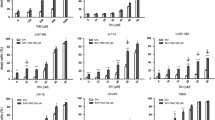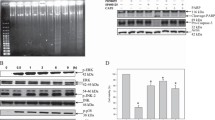Abstract
Cisplatin is commonly used for the treatment of malignant brain tumors. However, the mechanisms of cell death by cisplatin are not fully understood. Therefore, the present study was designed to elucidate the apoptotic signaling pathway(s) activated by cisplatin in a C6 rat glioma cell line. C6 cells were treated with various concentrations of cisplatin (0.2–10 μg/ml) for 24–72 h. At 10 μg/ml cisplatin, over 90% of the cells became dead at 72 h. Apoptotic death was confirmed by condensation and fragmentation of nuclei, and DNA laddering. Even in cells treated with 1.5 μg/ml cisplatin, typical apoptotic cells were observed at 72 h. The intracellular level of ceramide, measured Escherichia coli diacylglycerol kinase markedly increased during 24–72 h after the addition of 10 μg/ml cisplatin. The activity of caspase-3(-like) proteases increased and reached a peak at 48 h. Inhibitors of caspases reduced the number of apoptotic cells. Pretreatment of C6 cells with glutathione or N-acetyl-cysteine, which are known to block the activation of neutral magnesium-dependent sphingomyelinase, inhibited ceramide formation, leading to suppression of both activation of caspase-3(-like) proteases and apoptosis by cisplatin. In contrast, pretreatment of the cells with N-oleoylethanolamine (OE), a ceramidase inhibitor, potentiated apoptosis induced by cisplatin. Furthermore, OE enhanced sensitivity of the cisplatin-resistant cells to cisplatin. These results suggest that ceramide is closely implicated in apoptosis of glioma cells by cisplatin through activation of caspase-3(-like) proteases.
Similar content being viewed by others
References
Korsmeyer SJ: Bcl-2: an antidote to programmed cell death. Cancer Surv 15: 105–118, 1992
Weller M, Malipiero U, Aguzzi A, Reed JC, Fontana A: Protooncogene Bcl-2 gene transfer abrogates Fas/APO-1 antibody-mediated apoptosis of human malignant glioma cells and confers resistance to chemotherapeutic drugs and therapeutic irradiation. J Clin Invest 95: 2633–2643, 1995
Wyllie AH, Morris ARG, Smith AL, Dunlop D: Chromatin cleavage in apoptosis: association with condensed chromatin morphology and dependence on macromolecular synthesis. J Pathol 142: 67–77, 1984
Bergstrom P, Johnsson A, Cavallin SE, Bergenheim T, Henriksson R: Effects of cisplatin and amphotericin B on DNAadduct formation and toxicity in malignant glioma and normal tissues in rat. Eur J Cancer 1: 153–159, 1997
Dbaibo GS, Pushkareva MY, Rachid RA, Alter N, Smyth MJ, Obeid LM, Hannun YA: p53-dependent ceramide response to genotoxic stress. J Clin Invest 102: 329–339, 1998
Eastman A: Activation of programmed cell death by anticancer agents: cisplatin as a model system. Cancer Cells 2: 275–280, 1990
Hueber A, Winter S, Weller M: Chemotherapy primes malignant glioma cells for CD95 ligand-induced apoptosis up-stream of caspase 3 activation. Eur J Pharmacol 352: 111–115, 1998
Kondo S, Yin D, Morimura T, Kubo H, Nakatsu S, Takeuchi J: Combination therapy with cisplatin and nifedipine induces apoptosis in cisplatin-sensitive and cisplatinresistant human glioblastoma cells. Br J Cancer 71: 282–289, 1995
Kondo S, Yin D, Morimura T, Takeuchi J: Combination therapy with cisplatin and nifedipine inducing apoptosis in multidrug-resistant human glioblastoma cells. J Neurosurg 82: 469–474,1995
Ruan S, Okcu MF, Ren JP, Chiao P, Andreeff M, Levin V, Zhang W: Overexpressed WAF1/Cip1 renders glioblastoma cells resistant to chemotherapy agents 1,3-bis(2-chloroethyl)-1-nitrosourea and cisplatin. Cancer Res 58: 1538–1543, 1998
Yount GL, Haas KDA, Levine KS, Aldape KD, Israel MA: Ionizing radiation inhibits chemotherapy-induced apoptosis in cultured glioma cells: implications for combined modality therapy. Cancer Res 58: 3819–3825, 1998
Fritsche M, Haessler C, Brandner G: Induction of nuclear accumulation of the tumor-suppressor protein p53 by DNA-damaging agents. Oncogene 8: 307–318, 1993
Lang FF, Yung WK, Raju U, Libunao F, Terry NH, Tofilon PJ: Enhancement of radiosensitivity of wild-type p53 human glioma cells by adenovirus-mediated delivery of the p53 gene. J Neurosurg 89: 125–132, 1998
Alnemri TF, Litwack G, Alnemri ES: CPP32, a novel human apoptotic protein with homology to Caenorhabditis elegans cell death protein Ced-3 and mammalian interleukin-1β-converting enzyme. J Biol Chem 269: 30,761–30,764, 1994
Nicholson DW, Ali A, Thornberry NA, Vaillancourt JP, Ding CK, Gallant M, Gareau Y, Griffin PR, Labelle M, Lazebnik YA, Munday NA, Raju SM, Smulson ME, Yamin TT, Yu VL, Miller DK: Identification and inhibition of the ICE/CED-3 protease necessary for mammalian apoptosis. Nature 376: 37–43, 1995
Tewari M, Quan LT, O'Rourke K, Desnoyers S, Zeng Z, Beidler DR, Poiroer GC, Salvesen GS, Dixit VM: Yama/CPP32B, a Crm A-inhibitable protease that cleaves the death substrate poly(ADP-ribose) polymerase. Cell 81: 801–809, 1995
Alnemri ES, Livingston DJ, Nicholson WD, Salvesen G, Thornberry NA, Wong WW, Yuan J: Human ICE/CED-3 protease nomenclature. Cell 87: 171, 1996
Hannun YA: Functions of ceramide in coordinating cellular responses to stress. Science 274: 1855–1859, 1996
Kolesnick RN, Goñi FM, Alonso A: Compartmentalization of ceramide signaling: physical foundations and biological effects. J Cell Phys 184: 285–300, 2000
Yoshimura S, Sakai H, Ohguchi K, Nakashima S, Banno Y, Nishimura Y, Sakai N, Nozawa Y: Changes in the activity and mRNA levels of phospholipase D during ceramideinduced apoptosis in rat C6 glial cells. J Neurochem 69: 713–720, 1997
Sakai H, Nakashima S, Yoshimura S, Nishimura Y, Sakai N, Nozawa Y: Molecular cloning of a cDNA encoding a serine protease homologous to complement C1s precursor from rat C6 glial cells and its expression during glial differentiation. Gene 209: 87–94, 1998
Yoshimura S, Sakai H, Nakashima S, Nozawa Y, Shinoda J, Sakai N, Yamada H: Differential expression of Rho family GTP-binding proteins and protein kinase C isozymes during C6 glial cell differentiation. Mol Brain Res 45: 90–98, 1997
Yoshimura S, Banno Y, Nakashima S, Takenaka K, Sakai H, Nishimura Y, Sakai N, Shimazu S, Eguchi Y, Tsujimoto Y, Nozawa Y: Ceramide formation leads to caspase-3 activation during hypoxic PC12 cell death. J Biol Chem 273: 6921–6927, 1998
Liu B, Hannun YA: Inhibition of the neutral magnesiumdependent sphingomyelinase by glutathion. J Biol Chem 272: 16,281–16,287, 1997
Singh I, Pahan K, Khan M, Singh A: Cytokine-mediated induction of ceramide production is redox-sensitive. J Biol Chem 273: 20,354–20,362, 1998
Yoshimura S, Banno Y, Nakashima S, Hayashi K, Yamakawa H, Sawada M, Sakai N, Nozawa Y: Inhibition of neutral shingomyelinase activation and ceramide formation by glutathione in hypoxic PC 12 cell death. J Neurochem 73: 675–683, 1999
Smyth MJ, Perry DK, Zhang J, Poirier GG, Hannun YA, Obeid LM: prICE: a down stream target for ceramideinduced apoptosis and for the inhibitory action of Bcl-2. Biochem J 316: 25–28, 1996
Sawada M, Nakashima S, Banno Y, Yamakawa H, Hayashi K, Takenaka K, Nishimura Y, Sakai N, Nozawa Y: Ordering of ceramide formation, caspase activation, and Bax/Bcl-2 expression during etoposide-induced apotosis in C6 glioma cells. Cell Death Differ 7: 761–772, 2000
Wiesner DA, Kilkus JP, Gottschalk AR, Quintans J, Dawson G: Anti-immunoglobulin-induced apoptosis in WEHI 231 cells involves the slow formation of ceramide from sphingomyelin and is blocked by Bcl-XL. J Biol Chem 272: 9868–9876, 1997
Okazaki T, Bielawaka A, Bell RM, Hannun YA: Role of ceramide as a lipid mediator of 1β,25-dihydroxyvitamine D3-induced HL-60 cell differentiation. J Biol Chem 265: 15,823–15,831, 1990
Gomez-Munoza A, Martin A, O'Brient L, Brindley DN: Cell-permerable ceramides inhibit the stimulation of DNA synthesis and phospholipase D activity by phosphatidate and lysophosphatidate in rat fibroblasts. J Biol Chem 269: 8937–8943, 1994
Jayadev S, Liu B, Bielawska AE, Lee JY, Nazaire F, Pushkareva MY, Obeid LM, Hannun YA: Role of ceramide in cell cycle arrest. J Biol Chem 270: 2047–2052,1995
Verheij M, Bose R, Lin XH, Yao B, Jarvis WD, Grant S, Birrer MJ, Szabo E, Zon LI, Kyriakis JM, Haimovitz FA, Fuks Z, Kolesnick RN: Requirement for ceramide-initiated SAPK/JNK signalling in stress-induced apoptosis. Nature 380: 75–79, 1996
Sawai H, Okazaki T, Takeda Y, Tashima M, Sawada H, Okuma M, Kishi S, Umehara H, Domae N: Ceramideinduced translocation of protein kinase C-β and-β to the cytosol. J Biol Chem 272: 2452–2458, 1997
Tomiuk S, Hofmann K, Nix M, Zumbansen M, Stoffel W: Closed mammalian neutral sphingomyelinase: function in sphingolipid signaling? Proc Natl Acad Sci USA 95: 3638–3643, 1998
Lavie Y, Cao H, Volner A, Lucci A, Han T, Geffen V, Giuliano AE, Cabot MC: Agents that reverse multidrug resistance, tamoxifen, verapamil, and cyclosporin A, block glycosphingolipid metabolism by inhibiting ceramide glycosylation in human cancer cells. J Biol Chem 272: 1682–1687, 1997
Komori H, Ichikawa S, Hirabayashi Y, Ito M: Regulation of intracellular ceramide content in B16 melanoma cells. J Biol Chem 274: 8981–8987, 1999
Spinedi A, Bartolomeo SD, Piacentini M: N-Oleoylethanolamine inhibits glucosylation of natural ceramide in CHP-100 neuroepithelioma cells: possible implications for apoptosis. Biochem Biophys Res Commun 255: 456–459, 1999
Zou H, Li Y, Liu X, Wang X: An Apaf-1·cytochrome c multimeric complex is a functional apoptosome that activates procaspase-9. J Biol Chem 274: 11,549–11,556, 1999
Chal J, Du C, Wu J-W, Kyln S, Wang X, Shi Y: Structural and biochemical basis of apoptotic activation by Smac/DIABLO. Nature 406: 855–862, 2000
Srinvasula SM, Ahmad M, Fernandes-Almeri T, Alnemri ES: Autoactivation of procaspase-9 by Apaf-1 mediated oligomerization. Mol Cell 1: 949–957, 1998
Kluck RM, Bossy-Wetzel E, Green DR, Newmeyer DD: The release of cytochrome c from mitochondria: a primary site for Bcl-2 regulation of apoptosis. Science 275: 1132–1136, 1997
Bossy-Wetzel E, Newmeyer DD, Green DR: Mitochondrial cytochrome c release in apoptosis occurs upstream of DEVD-specific caspase activation and independently of mitochondrial transmembrane depolarization. EMBO J 17: 37–49, 1998
Henkels KM, Turchi JJ: Cisplatin-induced apoptosis proceeds by caspase-3-dependent and-independent pathways in cisplatin-resistant and-sensitive human ovarian cancer cell lines. Cancer Res 59: 3077–3083, 1999
Kitanaka C, Kuchino Y: Caspase-independent programmed cell death with necrotic morphology. Cell Death Differ 6: 508–515, 1999
Chautan M, Chazal G, Cecconi F, Gruss P, Golstein P: Interdigital cell death can occur through a necrotic and caspase-independent pathway. Curr Biol 9: 967–970, 1999
Moln´ar P, O'Neill BP, Scheithauer BW, Groothuis DR: The blood-brain barrier in primary CNS lymphomas: ultrastructural evidence of endothelial cell death. Neuro-Oncology 1: 89–100, 1999
Groothuis DR: The blood-brain and blood-tumor barriers: A review of strategies for increasing drug delivery. Neuro-Oncology 2: 45–59, 2000
Author information
Authors and Affiliations
Rights and permissions
About this article
Cite this article
Noda, S., Yoshimura, Si., Sawada, M. et al. Role of Ceramide During Cisplatin-induced Apoptosis in C6 Glioma Cells. J Neurooncol 52, 11–21 (2001). https://doi.org/10.1023/A:1010624823158
Issue Date:
DOI: https://doi.org/10.1023/A:1010624823158




